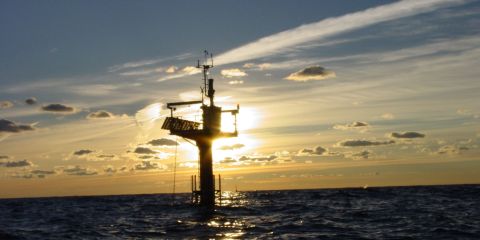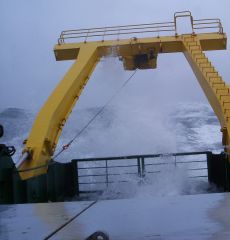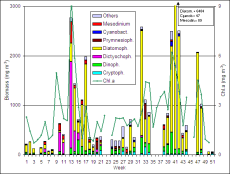

Phytoplankton development at the coastal station "Seebrücke Heiligendamm" and Kühlungsborn in 2007
The traditional weekly phytoplankton sampling by the Leibniz Institute for Baltic Sea Research (IOW) could not be performed as usual at the sea-bridge Heiligendamm (54°08,55' N; 11°50,60' E; 300 m off shore, 3 m water depth) from 16.1.-29.5.07 because of construction activities. Instead, sampling was performed at the sea-bridge Kühlungsborn (6 km west of Heiligendamm) during that time. Samples could not be taken during the week around the 5.6.2007 because of the G8-summit. After this event, samples were taken as usual in Heiligendamm. On 6.11.07, sampling was stopped because of a strong storm. 10 phytoplankton samples could not be analysed by microscope as they contained a lot of sediment. However, a chlorophyll analysis was possible.
The phytoplankton biomass was determined by microscopic counting (Utermöhl method) and the chlorophyll a concentration (corrected for phaeopigment) by ethanolic extraction and fluorometric measurement according to the HELCOM manual (http://www.helcom.fi/Monas/CombineManual2/CombineHome.htm). The phytoplankton counting was performed by using the counting software PhytoWin, which is linked with the official HELCOM phytoplankton list (Olenina et al. 2006).
The specific analytical conditions of the chlorophyll-a-determination are explained by Wasmund et al. (2006).
The relatively high chlorophyll concentrations on the first day of this investigation period was probably caused by wind-induced resuspension of sedimented material (wind force of 5 bft). Astonishingly, the phytoplankton was dominated by diatoms on that day, primarily Rhizosolenia setigera, Skeletonema "costatum", Proboscia alata and Guinardia flaccida. Despite of a taxonomic revision of the Skeletonema-species (vgl. Sarno et al., 2005) we retain provisionally the traditional name Skeletonema costatum. On 9.1.07, the diatoms Proboscia alata, Porosira glacialis, Thalassiosira punctigera, Skeletonema costatum and Rhizosolenia setigera made biomasses of more than 20 mg m-3 each. On 6.2.07 (week 6), the diatoms (Proboscia alata, Rhizosolenia setigera) were accompanied by Dictyocha speculum and Mesodinium rubrum, but those disappeared in the following 2 weeks again. Since week 10, Dictyocha speculum and Mesodinium rubrum established, while diatoms stayed on a low level. Only to week 13, diatoms (Coscinodiscus granii, Rhizosolenia setigera) grew. In the following weeks, Skeletonema costatum (accompanied by Rhizosolenia setigera, Chaetoceros decipiens) formed a bloom, whereas Dictyocha speculum and Mesodinium rubrum diminished. This succession is rather unusual. Usually, diatoms grow first, e.g. Thalassiosira- and Chaetoceros-species, sometimes also Rhizosolenia setigera and Porosira glacialis, followed by Skeletonema. Coscinodiscus granii belongs to the autumn community. Dictyocha speculum and dinoflagellates are normally expected after the diatom bloom. The peak of the diatom spring bloom was noticed on 24.4.07 (week 17), which is relatively late.
After the bloom, mixotrophic Chrysochromulina-species, cryptophyceae, dinoflagellates and small unidentified unicells developed. On 17.7.07 (week 29), the growth of typical summer diatoms started, like Cerataulina pelagica and Proboscia alata. The latter reached a biomass of 2047 mg m-3 on 7.8.07 (week 32) but disappeared quickly. Also this bloom was followed by Chrysochromulina spp. and cryptophyceae. Proboscia alata was widely replaced by Dactyliosolen fragilissimus (443 mg m-3 ) by the 14.8.07. On 21.8.07, the spring species Skeletonema "costatum" reached a biomass of 185 mg m-3.
After a three-weeks gap, caused by lots of sediment in the samples due to strong wind of 6-7 bft, the autumn diatom Coscinodiscus granii appeared shortly (326 mg m-3), but was replaced afterwards by Cerataulina pelagica and Ditylum brightwellii. Dactyliosolen fragilissimus dominated on 2.10.07 (week 40) with 1453 mg m-3 and reached its peak on 9.10.07 with 6436 mg m-3. It became unimportant already on 23.10.07 (week 43), whereas Cerataulina pelagica grew to 220 mg m-3. That species reached a peak on 20.11.07 with 1636 mg m-3. The total phytoplankton biomass was low in December as expected.
We may summarize, that the year 2007 had a unusual succession, e.g.:
- early Dictyocha-bloom, but late diatom spring bloom,
- diatom dominance in all seasons,
- unusually low dinoflagellate biomass, particularly because of the lack of a Ceratium-autumn bloom for the benefit of a strong diatom autumn bloom,
- low cyanobacteria biomass in comparison with the unusual year 2006.
The strong fluctuations in the species composition of the diatoms may be caused by currents which transport water bodies of different origin to the shallow coastal sampling station in short frequency.
Literature
Olenina, I., Hajdu, S., Andersson, A.,Edler, L., Wasmund, N., Busch, S., Göbel,
J., Gromisz, S., Huseby, S., Huttunen, M., Jaanus, A., Kokkonen, P., Ledaine,
I., Niemkiewicz, E. (2006): Biovolumes and size-classes of phytoplankton in
the Baltic Sea. Baltic Sea Environment Proceedings No.106, 144pp.
Internet access:
Paper: http://www.helcom.fi/stc/files/Publications/Proceedings/bsep106.pdf
Table: http://www.helcom.fi/stc/files/Publications/Proceedings/bsep106ANNEX1Biovolumes_web.xls
Sarno, D., Kooistra, W.H.C.F., Medlin, L., Percopo, I., Zingone, A., 2005. Diversity in the genus Skeletonema (Bacillariophyceae). II. An assessment of the taxonomy of S. costatum-like species with the description of four new species. J. Phycol. 41, 151-176.
Wasmund, N., Topp, I., Schories, D. (2006): Optimising the storage and extraction of chlorophyll samples. Oceanologia 48: 125-144.
IOW, 12.08.2008
Dr. Norbert Wasmund,
Susanne Busch,
Ina-Marie Topp,
Regina Hansen.

State of the Baltic Sea
- Annual Reports on the state of the Baltic Sea Environment
- Cruise Reports
- Data from the autonomous measuring stations
- Development of the suboxic and anoxic regions since 1969
- Baltic Thalweg transect since 2014
- Algal blooms at Heiligendamm since 1998
- "Major Baltic Inflow" December 2014
- "Major Baltic Inflow" January 2003
- Baltic saline barotropic inflows 1887 - 2018
- Further Reading

